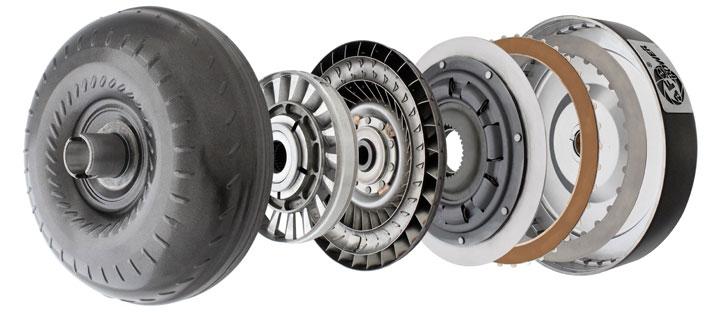In this article we are going to talk about the part of the automatic transmission called the torque converter. After reading, you will know how a torque converter works, symptoms of a bad torque converter, and its average replacement cost.
How a Torque Converter Works

Basically, the rotational power of engine torque is transferred to the transmission from the engine using a torque converter. This converter is installed and mounted onto a flex plate in between the transmission and engine. The crankshaft spins the flex plate to create the conversion effect.
Underneath the cover of the torque converter is a pump which contains a bunch of blades. These blades spin like a propeller in sync with the engine crankshaft. This causes fluid from the transmission to flow onto the blades of the impeller.
This particular blade assembly is attached to the input shaft of the transmission. The speed and gear of the vehicle is determined by how much hydraulic pressure is generated inside of the transmission through this process.
Symptoms of a Bad Torque Converter
Problems with the torque converter create symptoms that are often misconstrued as being a transmission that’s failing. As a result, people will end up paying thousands of dollars just to replace their transmission or have it rebuilt.
What they don’t realize is that it may be the torque converter malfunctioning instead. The cost of replacing the torque converter is much less than replacing the transmission.
When the torque converter becomes faulty, there is more work required to be done by the vehicle just to sustain the same speed levels. The operation of the engine will require more revolutions to take place per minute, which will decrease the transmission fluid pressure and fuel economy.

Worst of all, the system generates more heat which could create even more problems in other areas too. Here’s a list of the typical symptoms you’ll find with a faulty torque converter:
#1 – Slipping of the Transmission
When a torque converter has problems, they will show themselves quickly because it won’t be able to manage the fluid properly. Either too much fluid or not enough fluid will go into the transmission, causing the gears to become slippery which results in a decrease in acceleration.
The fuel economy of the vehicle will decrease as well. There could be a low amount of transmission fluid too, so you should first inspect the fluid as soon as you notice slipping taking place.
#2 – Problems with Gear Shifts
Any delayed or soft shifts could be the symptom of the torque converter’s lowered pressure output. Instead of the transmission shifts feeling nice and crisp, they will be rough and won’t engage the way they’re supposed to.
The best way to assist the transmission so it can shift its gears properly is to increase the torque converter’s output pressure. The only way to do that is to increase the RPM of the engine.
#3 – Vehicle Speed Problems
When the torque converter’s output is not consistent, it can result in the transmission decreasing or increasing the speed of the vehicle. Meanwhile, the throttle won’t have any concurrent changes because there will be varying hydraulic pressure.
Driving conditions could become dangerous when this happens, so don’t operate your vehicle on the road until the issue has been repaired. The variation experienced may have a shudder feeling, but it is still a good idea to have the transmission mounts inspected and to tighten or repair these mounts if need be prior to inspecting the torque converter.
#4 – Shuddering
If you drive at around 30 mph to 45 mph and you start to feel shudders, shakes, or vibrations, the reason might have to do with problems with the torque converter. The feeling will usually resemble that of moving over a bumpy road, so it should be easy to notice.
The act of shuddering will happen suddenly without warning and then go away suddenly. But you should definitely get your transmission inspected by a professional after the very first time you experience these vibrations.
#5 – Noise
When a torque converter goes bad, there are many different kinds of noises that can be made. First, there may be a whining noise that sounds like a power-steering pump with little fluid in it.
The assembly’s motor contains a mechanism that has clutches. When this mechanism goes bad, a rattling noise can be heard. This noise might not be so loud when the vehicle’s in park. However, once the transmission is put into gear, the frequency and volume of the rattling noise will increase, which spells trouble for your converter.
Torque Converter Replacement Cost
If you have experienced any of the symptoms mentioned above, then your torque converter possibly is at fault. The cost of getting your torque converter repaired will actually be more than just replacing the converter. However, have a mechanic or auto expert look at it first before making any decisions.
Most auto repair shops will charge someone anywhere from $600 to $1000 for a torque converter replacement job. If you would rather do the replacement job yourself, then a new torque converter will cost anywhere from $150 to $500.
The exact cost depends on the make and model of your vehicle. At least you’ll be cutting out the labor costs if you do it yourself. It is a big job though because the transmission will have to be removed so that the torque converter can be inspected and then replaced so if you’re a beginner, it’s not something you probably want to tackle.
The post 5 Symptoms of a Bad Torque Converter (and Replacement Cost) appeared first on CarTreatments.com.





















